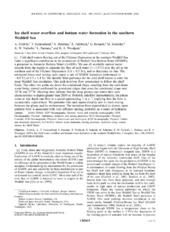| dc.contributor.author | Foldvik, Arne | eng |
| dc.contributor.author | Gammelsrød, Tor | eng |
| dc.contributor.author | Østerhus, Svein | eng |
| dc.contributor.author | Fahrbach, E. | eng |
| dc.contributor.author | Rohardt, G. | eng |
| dc.contributor.author | Schröder, Michael | eng |
| dc.contributor.author | Nicholls, Keith W. | eng |
| dc.contributor.author | Padman, L. | eng |
| dc.contributor.author | Woodgate, R. A. | eng |
| dc.date.accessioned | 2004-08-06T09:26:57Z | |
| dc.date.accessioned | 2004-08-26T11:59:29Z | |
| dc.date.available | 2004-08-06T09:26:57Z | |
| dc.date.available | 2004-08-26T11:59:29Z | |
| dc.date.issued | 2004-02-17 | eng |
| dc.identifier.issn | 0148-0227 | en_US |
| dc.identifier.uri | https://hdl.handle.net/1956/430 | |
| dc.description.abstract | Cold shelf waters flowing out of the Filchner Depression in the southern Weddell Sea make a significant contribution to the production of Weddell Sea Bottom Water (WSBW), a precursor to Antarctic Bottom Water (AABW). We use all available current meter records from the region to calculate the flux of cold water (<−1.9°C) over the sill at the northern end of the Filchner Depression (1.6 ± 0.5 Sv), and to determine its fate. The estimated fluxes and mixing rates imply a rate of WSBW formation (referenced to −0.8°C) of 4.3 ± 1.4 Sv. We identify three pathways for the cold shelf waters to enter the deep Weddell Sea circulation. One path involves flow constrained to follow the shelf break. The other two paths are down the continental slope, resulting from the cold dense water being steered northward by prominent ridges that cross the continental slope near 36°W and 37°W. Mooring data indicate that the deep plumes can retain their core characteristics to depths greater than 2000 m. Probably aided by thermobaricity, the plume water at this depth can flow at a speed approaching 1 m s−¹, implying that the flow is occasionally supercritical. We postulate that such supercriticality acts to limit mixing between the plume and its environment. The transition from supercritical to slower, more uniform flow is associated with very efficient mixing, probably as a result of hydraulic jumps. | en_US |
| dc.format.extent | 73153 bytes | eng |
| dc.format.extent | 137 bytes | eng |
| dc.format.extent | 662880 bytes | eng |
| dc.format.mimetype | text/plain | eng |
| dc.format.mimetype | text/plain | eng |
| dc.format.mimetype | application/pdf | eng |
| dc.language.iso | eng | eng |
| dc.publisher | American Geophysical Union | en_US |
| dc.subject | Bottom water formation | eng |
| dc.subject | Mixing processes | eng |
| dc.subject | Hydraulic jump | eng |
| dc.subject | Current meters | eng |
| dc.subject | Ice Shelf Water | eng |
| dc.title | Ice shelf water overflow and bottom water formation in the southern Weddell Sea | en_US |
| dc.type | Peer reviewed | |
| dc.type | Journal article | |
| dc.description.version | publishedVersion | en_US |
| dc.rights.holder | Copyright 2004 the American Geophysical Union | en_US |
| dc.source.articlenumber | C02015 | |
| dc.identifier.doi | https://doi.org/10.1029/2003jc002008 | |
| dc.identifier.cristin | 418952 | |
| dc.source.journal | Journal of Geophysical Research | |
| dc.source.40 | 109 | |
